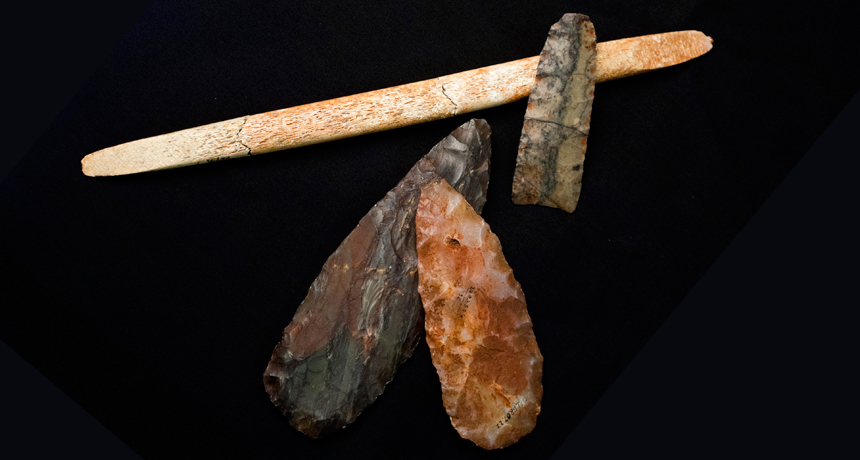
NATIVE ROOTS A baby who died some 12,600 years ago is giving new clues about the genetic origins of Native Americans. Stone and bone tools (shown) buried with the infant identify him as one of the Clovis people, a culture that dominated the United States and northern Mexico between 13,000 and 12,600 years ago.
S. L. Anzick
- More than 2 years ago
An ancient baby’s skeleton has revealed through its DNA that all Native Americans descended from a single gene pool with roots in Asia.
The bones belong to an infant that died between 12,707 and 12,556 years ago in Montana. The baby was covered in red ochre and buried on a hillside along with more than 100 stone and bone tools characteristic of Clovis people, a Paleo-Indian culture that was widespread in North America at the time. The grave of the 1-year-old boy, discovered by construction workers in 1968, is the only Clovis burial site ever found.
A report in the Feb. 13 Nature details the child’s genetic makeup and suggests that the Clovis people were ancestors of all present-day Native Americans. The Clovis baby, known as Anzick-1, like today’s Native Americans, can trace part of his heritage to a child known as the Mal’ta boy, who lived in Siberia 24,000 years ago (SN: 12/28/13, p. 16). The finding suggests that Native American populations have a common Asian heritage.
“This clearly shows that the homeland of the first Americans was Asia,” says study coauthor Michael Waters, a geologist and archaeologist at Texas A&M University in College Station.
The study may put to rest the idea, known as the Solutrean hypothesis, that ancient Europeans crossed the Atlantic and established the Clovis culture in the New World. “It’s not the last nail in the coffin, it’s the last spade full of earth on the grave of the Solutrean hypothesis,” says Jennifer Raff, an anthropological geneticist at the University of Texas at Austin who was not involved in the work.
The study may also settle speculation about the Clovis people’s relationship to modern Native Americans. Clovis culture was widespread between 13,000 and 12,600 years ago, but other styles of tool making eventually replaced the distinctive Clovis stone spear points. Along with other evidence, that suggested that the Clovis people may have been replaced by later groups settling the Americas.
“Their technology and tools vanished, but now we understand that their genetic legacy lives on,” says coauthor Sarah Anzick, a molecular biologist who was 2 years old when the baby’s grave was found on her family’s land. She made it a personal project to decipher the Clovis baby’s DNA.
The results for the first time establish that the Clovis people are direct ancestors of all modern Native Americans, says Connie Mulligan, a molecular anthropologist at the University of Florida in Gainesville. That’s no surprise to native people, says Shane Doyle, a professor of Native American studies at Montana State University in Bozeman and a member of the Crow tribe. “This discovery confirms what tribes have never really doubted; that we’ve been here since time immemorial.”
The analysis also reveals new details about the origins of native people in the Americas. The Anzick baby has the same amount of genetic ancestry from the Mal’ta people as other Native Americans; about one-third of his genome traces back to the ancient Siberian people, says study coauthor Eske Willerslev, an evolutionary geneticist at the University of Copenhagen. The remainder comes from an ancestral East Asian population, Willerslev says. The finding suggests that East Asians and Siberians interbred before the Clovis era to create the founding population from which all Native Americans descended.
About 80 percent of Native Americans, mainly those in Central and South America, are direct descendants of the Anzick baby’s people, Willerslev says. Other native peoples, such as those in Canada, are also closely related to the Clovis child, but from a different branch of the family. That suggests that the Native Americans’ original founders split into at least two groups, one that gave rise to the people of Central and South America and one whose descendants now populate the northern part of the Americas. The researchers have no data from native peoples in United States and can’t say how they fit into the family picture.
Anzick and members of several Native American tribes are preparing to rebury the baby’s remains where his parents left him more than 12,000 years ago.







